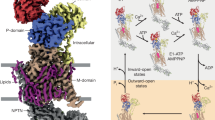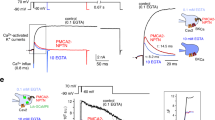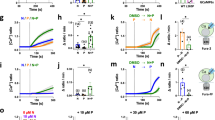Abstract
We set out to identify molecular mechanisms underlying the onset of necrotic Ca2+ overload, triggered in two epithelial cell lines by oxidative stress or metabolic depletion. As reported earlier, the overload was inhibited by extracellular Ca2+ chelation and the cation channel blocker gadolinium. However, the surface permeability to Ca2+ was reduced by 60%, thus discarding a role for Ca2+ channel/carrier activation. Instead, we registered a collapse of the plasma membrane Ca2+ ATPase (PMCA). Remarkably, inhibition of the Na+/K+ ATPase rescued the PMCA and reverted the Ca2+ rise. Thermodynamic considerations suggest that the Ca2+ overload develops when the Na+/K+ ATPase, by virtue of the Na+ overload, clamps the ATP phosphorylation potential below the minimum required by the PMCA. In addition to providing the mechanism for the onset of Ca2+ overload, the crosstalk between cation pumps offers a novel explanation for the role of Na+ in cell death.
Similar content being viewed by others
Log in or create a free account to read this content
Gain free access to this article, as well as selected content from this journal and more on nature.com
or
Abbreviations
- KRH:
-
Krebs–Ringer–Hepes buffer
- NCX:
-
Na+/Ca2+ exchanger
- PMCA:
-
plasma membrane Ca2+ ATPase
- VOCC:
-
voltage-operated Ca2+ channel
- NVI:
-
necrotic volume increase
- LDH:
-
lactate dehydrogenase
- PI:
-
propidium iodide
References
Majno G and Joris I (1995) Apoptosis, oncosis, and necrosis. An overview of cell death. Am. J. Pathol. 146: 3–15
Zahrebelski G, Nieminen AL, al Ghoul K, Qian T, Herman B and Lemasters JJ (1995) Progression of subcellular changes during chemical hypoxia to cultured rat hepatocytes: a laser scanning confocal microscopic study. Hepatology 21: 1361–1372
Ha HC and Snyder SH (1999) Poly(ADP-ribose) polymerase is a mediator of necrotic cell death by ATP depletion. Proc. Natl. Acad. Sci. USA 96: 13978–13982
Barros LF, Hermosilla T and Castro J (2001) Necrotic volume increase and the early physiology of necrosis. Comp. Biochem. Physiol. A 130: 401–409
Lee JM, Zipfel GJ and Choi DW (1999) The changing landscape of ischaemic brain injury mechanisms. Nature 399: A7–A14
Ermak G and Davies KJ (2002) Calcium and oxidative stress: from cell signaling to cell death. Mol. Immunol. 38: 713–721
Castro J, Bittner CX, Humeres A, Montecinos VP, Vera JC and Barros LF (2004) A cytosolic source of calcium unveiled by hydrogen peroxide with relevance for epithelial cell death. Cell Death Differ. 11: 468–478
Herson PS, Lee K, Pinnock RD, Hughes J and Ashford ML (1999) Hydrogen peroxide induces intracellular calcium overload by activation of a non-selective cation channel in an insulin-secreting cell line. J. Biol. Chem. 274: 833–841
Aarts M, Iihara K, Wei WL, Xiong ZG, Arundine M, Cerwinski W, MacDonald JF and Tymianski M (2003) A key role for TRPM7 channels in anoxic neuronal death. Cell 115: 863–877
Xiong ZG, Zhu XM, Chu XP, Minami M, Hey J, Wei WL, MacDonald JF, Wemmie JA, Price MP, Welsh MJ and Simon RP (2004) Neuroprotection in ischemia: blocking calcium-permeable acid-sensing ion channels. Cell 118: 687–698
Schwab BL, Guerini D, Didszun C, Bano D, Ferrando-May E, Fava E, Tam J, Xu D, Xanthoudakis S, Nicholson DW, Carafoli E and Nicotera P (2002) Cleavage of plasma membrane calcium pumps by caspases: a link between apoptosis and necrosis. Cell Death Differ. 9: 818–831
Barros LF, Kanaseki T, Sabirov R, Morishima S, Castro J, Bittner CX, Maeno E, Ando-akatsuka Y and Okada Y (2003) Apoptotic and necrotic blebs in epithelial cells display similar neck diameters but different kinase dependency. Cell Death Differ. 10: 687–697
Bortner CD and Cidlowski JA (2002) Cellular mechanisms for the repression of apoptosis. Annu. Rev. Pharmacol. Toxicol. 42: 259–281
Barros LF, Castro J and Bittner CX (2002) Ion movements in cell death: from protection to execution. Biol. Res. 35: 209–214
Klishin A, Sedova M and Blatter LA (1998) Time-dependent modulation of capacitative Ca2+ entry signals by plasma membrane Ca2+ pump in endothelium. Am. J. Physiol. 274: C1117–C1128
Bortner CD and Cidlowski JA (2003) Uncoupling cell shrinkage from apoptosis reveals that Na+ influx is required for volume loss during programmed cell death. J. Biol. Chem. 278: 39176–39184
Carini R, Bellomo G, Benedetti A, Fulceri R, Gamberucci A, Parola M, Dianzani MU and Albano E (1995) Alteration of Na+ homeostasis as a critical step in the development of irreversible hepatocyte injury after adenosine triphosphate depletion. Hepatology 21: 1089–1098
Barros LF, Stutzin A, Calixto A, Catalán M, Castro J, Hetz C and Hermosilla T (2001) Non-selective cation channels as effectors of free radical-induced rat liver cell necrosis. Hepatology 33: 114–122
Sheldon C, Diarra A, Cheng YM and Church J (2004) Sodium influx pathways during and after anoxia in rat hippocampal neurons. J. Neurosci. 24: 11057–11069
Greger R (2000) Membrane voltage and preservation of the ionic distribution across the cell membrane. In Comprehensive Human Physiology, Greger R, Windhurst U, eds (Berlin Germany: Springer-Verlag) Chapter 11, pp. 245–266
Yu SP (2003) Na(+), K(+)-ATPase: the new face of an old player in pathogenesis and apoptotic/hybrid cell death. Biochem. Pharmacol. 66: 1601–1609
Simon F, Varela D, Eguiguren AL, Diaz LF, Sala F and Stutzin A (2004) Hydroxyl radical activation of a Ca(2+)-sensitive nonselective cation channel involved in epithelial cell necrosis. Am. J. Physiol. Cell Physiol. 287: C963–C970
Wang H and Joseph JA (2000) Mechanisms of hydrogen peroxide-induced calcium dysregulation in PC12 cells. Free Radic. Biol. Med. 28: 1222–1231
Xu K, Tavernarakis N and Driscoll M (2001) Necrotic cell death in C. elegans requires the function of calreticulin and regulators of Ca(2+) release from the endoplasmic reticulum. Neuron 31: 957–971
Favero TG, Zable AC and Abramson JJ (1995) Hydrogen peroxide stimulates the Ca2+ release channel from skeletal muscle sarcoplasmic reticulum. J. Biol. Chem. 270: 25557–25563
Peters SM, Tijsen MJ, van Os CH, Wetzels JF and Bindels RJ (1998) Hypoxia decreases calcium influx into rat proximal tubules. Kidney Int. 53: 703–708
Nicotera P, Hartzell P, Baldi C, Svensson SA, Bellomo G and Orrenius S (1986) Cystamine induces toxicity in hepatocytes through the elevation of cytosolic Ca2+ and the stimulation of a nonlysosomal proteolytic system. J. Biol. Chem. 261: 14628–14635
Zaidi A and Michaelis ML (1999) Effects of reactive oxygen species on brain synaptic plasma membrane Ca(2+)-ATPase. Free Radic. Biol. Med. 27: 810–821
Zaidi A, Barron L, Sharov VS, Schoneich C, Michaelis EK and Michaelis ML (2003) Oxidative inactivation of purified plasma membrane Ca2+-ATPase by hydrogen peroxide and protection by calmodulin. Biochemistry 42: 12001–12010
Bianchi L, Gerstbrein B, Frokjaer-Jensen C, Royal DC, Mukherjee G, Royal MA, Xue J, Schafer WR and Driscoll M (2004) The neurotoxic MEC-4(d) DEG/ENaC sodium channel conducts calcium: implications for necrosis initiation. Nat. Neurosci. 7: 1337–1344
Mochizuki S and MacLeod KT (1997) Effects of hypoxia and metabolic inhibition on increases in intracellular Ca2+ concentration induced by Na+/Ca2+ exchange in isolated guinea-pig cardiac myocytes. J. Mol. Cell. Cardiol. 29: 2979–2987
Schraufstatter IU, Hyslop PA, Hinshaw DB, Spragg RG, Sklar LA and Cochrane CG (1986) Hydrogen peroxide-induced injury of cells and its prevention by inhibitors of poly(ADP-ribose) polymerase. Proc. Natl. Acad. Sci. USA 83: 4908–4912
Hyslop PA, Hinshaw DB, Halsey Jr WA, Schraufstatter IU, Sauerheber RD, Spragg RG, Jackson JH and Cochrane CG (1988) Mechanisms of oxidant-mediated cell injury. The glycolytic and mitochondrial pathways of ADP phosphorylation are major intracellular targets inactivated by hydrogen peroxide. J. Biol. Chem. 263: 1665–1675
Colussi C, Albertini MC, Coppola S, Rovidati S, Galli F and Ghibelli L (2000) H2O2-induced block of glycolysis as an active ADP-ribosylation reaction protecting cells from apoptosis. FASEB J. 14: 2266–2276
Spragg RG, Hinshaw DB, Hyslop PA, Schraufstatter IU and Cochrane CG (1985) Alterations in adenosine triphosphate and energy charge in cultured endothelial and P388D1 cells after oxidant injury. J. Clin. Invest. 76: 1471–1476
Fossel ET and Solomon AK (1978) Ouabain-sensitive interaction between human red cell membrane and glycolytic enzyme complex in cytosol. Biochim. Biophys. Acta 510: 99–111
Mercer RW and Dunham PB (1981) Membrane-bound ATP fuels the Na/K pump. Studies on membrane-bound glycolytic enzymes on inside-out vesicles from human red cell membranes. J. Gen. Physiol. 78: 547–568
Hardin CD, Raeymaekers L and Paul RJ (1992) Comparison of endogenous and exogenous sources of ATP in fueling Ca2+ uptake in smooth muscle plasma membrane vesicles. J. Gen. Physiol. 99: 21–40
Chinopoulos C, Tretter L, Rozsa A and Adam-Vizi V (2000) Exacerbated responses to oxidative stress by an Na(+) load in isolated nerve terminals: the role of ATP depletion and rise of [Ca(2+)](i). J. Neurosci. 20: 2094–2103
Elliott SJ, Eskin SG and Schilling WP (1989) Effect of t-butyl-hydroperoxide on bradykinin-stimulated changes in cytosolic calcium in vascular endothelial cells. J. Biol. Chem. 264: 3806–3810
Elliott SJ and Schilling WP (1992) Oxidant stress alters Na+ pump and Na(+)–K(+)–Cl- cotransporter activities in vascular endothelial cells. Am. J. Physiol. 263: H96–H102
Reyes JG, Bacigalupo J, Araya R and Benos DJ (1994) Ion dependence of resting membrane potential of rat spermatids. J. Reprod. Fertil. 102: 313–319
Diarra A, Sheldon C and Church J (2001) In situ calibration and [H+] sensitivity of the fluorescent Na+ indicator SBFI. Am. J. Physiol. Cell Physiol. 280: C1623–C1633
Nadal A, Fuentes E and McNaughton PA (1996) Albumin stimulates uptake of calcium into subcellular stores in rat cortical astrocytes. J. Physiol. (London). 492: 737–750
Hallam TJ and Rink TJ (1985) Agonists stimulate divalent cation channels in the plasma membrane of human platelets. FEBS Lett. 186: 175–179
Alzamora R, Marusic ET, Gonzalez M and Michea L (2003) Nongenomic effect of aldosterone on Na+,K+-adenosine triphosphatase in arterial vessels. Endocrinology 144: 1266–1272
Acknowledgements
IR, CF and EV are students at the Universidad Austral de Chile. We thank Karen Everett for critical reading of the manuscript. This work was funded by Fondecyt Grants 1020648 and 1051082 (to LFB), 1050690 (to LM) and 3030065 (to SH). The Centro de Estudios Científicos (CECS) receives institutional support from Empresas CMPC, the Millenium Science Initiative, Fundación Andes and the Tinker Foundation.
Author information
Authors and Affiliations
Corresponding author
Additional information
Edited by JA Cidlowski
Rights and permissions
About this article
Cite this article
Castro, J., Ruminot, I., Porras, O. et al. ATP steal between cation pumps: a mechanism linking Na+ influx to the onset of necrotic Ca2+ overload. Cell Death Differ 13, 1675–1685 (2006). https://doi.org/10.1038/sj.cdd.4401852
Received:
Revised:
Accepted:
Published:
Issue date:
DOI: https://doi.org/10.1038/sj.cdd.4401852
Keywords
This article is cited by
-
Metabolic regulation of calcium pumps in pancreatic cancer: role of phosphofructokinase-fructose-bisphosphatase-3 (PFKFB3)
Cancer & Metabolism (2020)
-
Autophagy, Apoptosis, Mitoptosis and Necrosis: Interdependence Between Those Pathways and Effects on Cancer
Archivum Immunologiae et Therapiae Experimentalis (2013)
-
Performance of optical flow techniques for motion analysis of fluorescent point signals in confocal microscopy
Machine Vision and Applications (2012)
-
Secondary necrosis in multicellular animals: an outcome of apoptosis with pathogenic implications
Apoptosis (2008)



